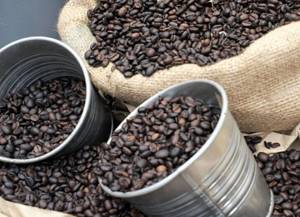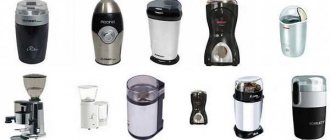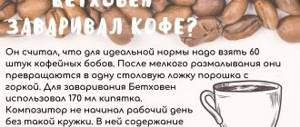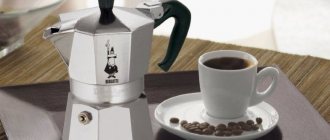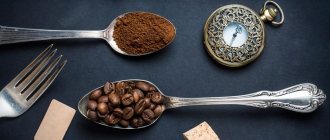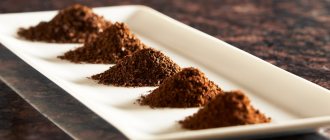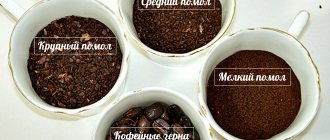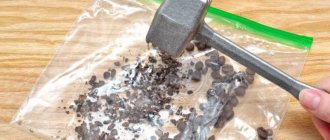Making changes to the grinder settings
A coffee grinder has a pair of blades called burrs, the top of which can be adjusted to change how coarse or fine the ground coffee becomes.
Since each coffee has its own specific tendencies and therefore its own sweet spot, it may take a little trial and error to find that sweet spot.
The question of “how to properly adjust the grind on a coffee grinder” and making changes to the grinder settings can be a daunting prospect, however, contrary to many misconceptions, it is actually not such a difficult procedure.
Proper grinding of beans determines the aroma and quality of coffee as a drink. Each type of coffee contains beans of different sizes and densities, and after roasting their moisture level continues to change. The quality of grinding is also affected by changes in environmental factors: humidity, pressure and ambient temperature.
The percentage of air humidity, indoor and outdoor temperatures, and atmospheric pressure levels change throughout the day. Therefore, when adjusting the grinding in a coffee grinder, you need to take into account the season (heat, cold, snow, wind, dryness or rain), room heating, even the operation of the air conditioner and humidifier.
As air humidity increases, coffee granules begin to swell, pressing closer together. This factor increases the extraction time of the coffee, making it bitter. Due to low humidity, on the contrary, the opposite effect occurs: the distance between the granules increases, the coffee cooks faster, reducing the density, and the taste of the drink becomes sour. If the grind is too fine, the coffee will be bitter. Coarse grinding produces watery and unsaturated coffee, and the cream will form a very thin layer.
In this regard, when air humidity increases, you need to change the grinding of the coffee grinder. When indoor humidity increases, the grind needs to be coarser. Otherwise the coffee will become bitter.
With a decrease in air humidity, an unpleasant sourness appears in the drink, as coffee beans lose moisture, the distance between particles becomes greater, and the time for extracting useful substances is shortened. Therefore, the grinding needs to be changed to a finer degree.
We should also not forget about the freshness of the coffee beans and the service life of the coffee grinder, where the millstones have their own expiration date. Worn millstones will produce uneven grinding. Coffee grinder blades need to be changed once a year.
How grinding affects coffee
With fine grinding, the shades embedded in the grain appear more vividly. However, if the grind is too fine, the coffee will taste bitter because the grains of the beans fit too tightly together, and water passes through with difficulty. With coarse grinding, the drink will have a sour tint, since water spills between large particles quickly, without having time to absorb all the necessary substances from the grain, which spoils the taste of coffee.
By the way, when adjusting the grinding, you should also take into account the humidity in the room. With high humidity, coffee grains can stick together and increase in size, which makes the drink bitter. In a too dry room, it’s the other way around: sourness appears in the drink. In addition, different types of coffee may taste different due to extraction - when a certain amount of substances is washed out from the ground beans. If the beans you choose have more bitterness or sourness, then as the degree of grinding decreases, they will increase.
Types of coffee grinding
Coarse grinding (coffee particle size up to 0.8 mm). With this type of grinding, extraction (transfer of soluble substances into the drink) requires 4 minutes.
Medium grind (coffee particle size 0.4 – 0.5 mm). This grind size is called universal. The best extraction time is 4 to 6 minutes.
Fine grinding (coffee particle size up to 0.15 mm). The extraction duration should be 1 - 4 minutes.
Setting the grind size of your coffee grinder is an important and critical step in getting great coffee. The whim of ground coffee is no less than the whim of coffee beans.
Coffee professionals change the grind setting of their coffee grinder several times a day. The reason for this is that coffee, as a good adsorbent, absorbs odors and moisture from the environment. Therefore, the grind cannot be the same at the end and at the beginning of the day.
No one changes the coffee grinder and the barista many times during the day; the only thing the barista “plays” with is the grind. If the grind is very fine, the coffee will flow slowly and will taste very bitter. With coarse grinding, the coffee will spill too quickly and all the necessary components that give the specific taste of coffee will not be transferred into the drink. The drink will be watery, that is, we get underextraction. The cream will also not be stable on the surface. Therefore, you should look for a middle ground.

By adjusting the degree of grinding of the coffee grinder, you can correct excess bitterness or sourness, and achieve more or less richness.
The quality of the drink is also influenced by other factors: grain quality, temperature, water, skill and mood of the barista, and much more.
But other things being equal, it is the degree of grinding that is the value that should regulate all other factors. The grind size is not a constant value; you cannot adjust the coffee grinder once and for all.
The millstones wear out during operation and increase in size due to heating; in addition, the micrometric regulator changes its position due to vibration.
The choice of grind level is influenced by the coffee brewing method. Factors such as brewing time, temperature, pressure are also important.
Balanced all parameters will create the condition that from 18% to 25% of the soluble flavoring components contained in the grain are transferred into the drink. According to the SCAE brew chart, a TDS (refractometer solids concentration) range of 1.15 to 1.35 produces rich, flavorful coffee. This is the central yellow square on the graph.

What is more important for grinding
Also check out these articles
- High-quality and reliable furniture for furnishing your own home
- DIY microwave welding
- Secure storage of things is the right solution
- Chairs for cafes and bars
Coarse grinding of beans means the coffee will sour. Excessively fine grain - the drink will be bitter. The reason is not only the crushed product, but also the extraction. Selecting your standard - the amount of the mixture that is washed out of the powder with water. You can try it and see for yourself. Grind different types of coffee 5 times on 1 coffee grinder, the drink will give its own taste.
If the grain is ground too finely, the grains will become closer to each other as granules. It will be difficult for water to pass through the grains - the coffee will taste bitter. Large fractions of coffee after grinding will not be washed with a portion of adjusted water, which means the drink will begin to sour.
When to change your coffee grinder grind settings
The coffee grinder grinding settings must be changed in the following cases:
- When changing the type of coffee
- When environmental conditions change: air temperature, humidity level or atmospheric pressure.
- If the coffee grinder blade is worn out.
Coffee grinders never produce a completely uniform grind. Ground coffee will always have larger particles and dust mixed in. To obtain a more or less uniform grind, the ground grain must be passed through a metal sieve of the required diameter. This separates particles that are too large and too small.
Grinding adjustment algorithm
Typically, espresso brewing takes about 25 seconds, so if you don't hit that mark consistently, you'll need to make some adjustments to your grinder settings.
To change settings, follow this simple step-by-step guide:
First, determine whether you need to make the grind finer or coarser.
The grinding on a coffee grinder is adjusted using a disk located under the hopper, that is, a container for storing coffee beans. To obtain a finer grind, only when the device is turned on, the disk is rotated towards the FINE inscription. To make a coarse grind, turn the dial towards the inscription COARSE (GROSS or GROSSA). This is possible with the coffee grinder turned on and off.
- You need to move the disk ring one mark at a time in the appropriate direction.
- First, turn on the disc for ten seconds so that no particles from the previous grind remain.
- Make a test espresso, remembering to keep your dose and tamping technique the same to eliminate any other variables.
- Estimate how long it took to brew this espresso.
- Was the coffee brewed for the optimal time and what does it taste like?
- Repeat if necessary.
Remember that when changing the spacing of the burrs, you must do so in very small increments.
Even three millimeters of movement of the dial can change the extraction time of the coffee by about three to five seconds, so you shouldn't make major changes unless you feel the need to.
Once the best result is found, write down the settings. It's worth writing down because you can use them as your default setting.
Temperature and changing conditions during the working day can sometimes affect the nuances of the coffee, so regular “espresso checks” are suggested to ensure ideal settings are always being used.

What are espresso checks
Before you start changing the settings of a professional coffee grinder, you need to grind the coffee beans for one serving and prepare espresso, measuring the extraction time. If it took less than 22 seconds, then the grind is coarse, if it takes more than 28 seconds, then it is fine.
To determine the quality of the grind, you will need an accurate scale and a stopwatch to determine the coffee extraction time.
To change the grinding settings of the coffee grinder, you need to grind coffee beans for one serving and prepare espresso. In this case, you need to record the time from the moment the espresso is turned on until it ends. If it took less than 22 seconds to prepare the drink, then the grind is coarse; if it takes more than 28 seconds, then the grind is fine.
The ideal extraction time for espresso is 25 seconds. Deviations from the ideal according to specialty coffee standards are ±3 seconds and ±3 ml; ±5 is acceptable in commercial standards. Great if you measure temperature and TDS, but much better if you can judge the appearance and taste of espresso like a pro.
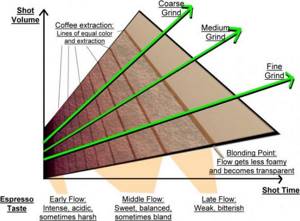
Recommendations for setting the grind of a professional coffee grinder
Coarse grinding is used to prepare coffee in geyser (steam) coffee makers. For this brewing method, you can also use a medium grind.
Medium grind is suitable for many types of brewing, but is primarily used for French press coffee.
Fine grinding is suitable for espresso and filter (drip) coffee makers.
Powdered ultrafine grinding is used to prepare oriental coffee in Turk (cezve). This is the only type of brewing in which the coffee is served with grounds.
Grinding devices
Manual coffee grinder
Coffee grinders are manual and automatic. The difference between the two is that the manual device is activated by a handle. It is rotated clockwise and the millstones are activated.
The advantage of such coffee grinders is their low cost and autonomous operation. You don't have to look for an outlet or buy batteries.
The disadvantage is that you cannot choose the degree of grinding and obtain powder fractions. Only a medium grind is obtained.
It will not be possible to achieve perfectly ground beans. Some of them will not be completely crushed.
Another disadvantage is that you will have to make an effort to manually grind a large number of grains.
Interesting! What is mocha coffee and how to make it?
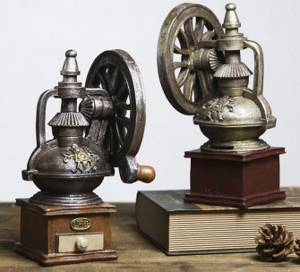
Electrical device
This coffee grinder is often equipped with an additional function - you can select the degree of grinding using the switch lever.
Also among the advantages is that the unit works independently and ideally grinds grains.
The downside is that it works on the network and the high price.
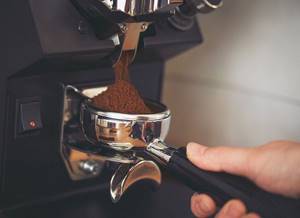
Each coffee preparation method requires a different grind.
Experts recommend grinding the grains immediately before cooking, since with this grinding the essential oils evaporate much faster.
French press grind: very coarse
The coarsest grind size is suitable for a French press. The particles should be approximately 0.8 mm in size. Soluble substances pass into the drink within 4 minutes. When using medium coarse grinding for a French press, the extraction time must be reduced to 3 minutes. Coffee from this brewing method is distinguished by its dense body, richness in oils, and excellent aroma. To evaluate all the flavor and aroma characteristics of coffee, professionals use a French press.
Grinding for filter coffee makers: coarse
Coarse grinding is suitable for filter machines and drip coffee makers. The Brazilian open cup coffee system also requires a coarse grind. When tasting coffee, the basis is based on drinks prepared using the Brazilian method and from filter coffee makers. This is the grinding standard and brewing methods considered canons. They are well documented in the SCAA, SCAE, COE and WCE regulations.
Grinding for pourovers: medium coarse
For pour overs, Chemex and Clever, the coarsest grind is usually used. Because they use elements of infusion. Extra thick Chemex filter paper allows the coffee to drip slowly. And Clever has a special valve to retain water in the funnel. Therefore, many do not classify them as a pour-over method.
Alternative brewing methods allow for different coffee profiles. The grind size is influenced by the way the filters are folded, the shape of the funnels, and different types and flavors of coffee. The coarser the grind, the higher the temperature, and vice versa, the finer the grind, the lower the temperature. The larger the funnel, the coarser the grind.
For siphon coffee makers, medium-coarse grinding is also used. The drip method with filters also requires a coarser grind.
Universal grinding: medium
Universal, that is, medium grinding, suitable for geyser-type coffee makers (moka), home espresso machines, and carob coffee makers.
The grind is coarser than espresso, but finer than pour over, suitable for Aeropress. Whether the grind is suitable is checked by extraction. If the drink turns out rich and tasty, then everything is fine.
Almost all ground coffee sold has this average grind.
Espresso grind: fine-medium
The method of brewing espresso is the most capricious when it comes to grinding. Almost all drinks are based on espresso and therefore coffee shops are striving to increase their assortment. If the espresso turns out to be frankly bad, then the other drink will not work either.
In the barista championship, espresso was defined as follows: it is a drink prepared in a special coffee machine by passing 25±5 ml of water under a pressure of 9 bar at a temperature range of 85-98°C for 25±5 seconds. through a layer of tightly compacted, finely-ground coffee.
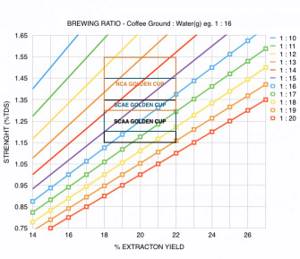
Adjusting the coffee grind in a coffee machine
You can adjust the grinding of coffee beans in a coffee machine using a special adjustment disc. It has a scale with divisions and inscriptions, FINE means on the right, GROS on the left. However, the designation of the degree of grinding in different models of coffee machines may differ.
- To decrease the grinding, turn the knob to the right, to increase - to the left. It is believed that shifting the regulator by one notch changes the extraction time by 2-3 seconds.
- Adjusting the grind of the coffee machine is carried out only with the knives running, otherwise the rotary switch may be damaged.
- In automatic coffee machines, when changing the grind level, the result appears after preparing 2-3 servings, so there is no point in turning the dial after each cup.
What is the best coffee grind for a coffee machine? It should be fine enough, but when grinding to a minimum degree, the strainer may become clogged. Also, too fine a grind has a negative impact on the operation of the brewing mechanism. The quality of grinding can be determined by the particle size of the crushed coffee beans. Granules with a diameter of 0.5 mm are considered medium; they feel like sugar or river sand to the touch. Large particles include particles 0.8 mm in size, reminiscent of household salt. We are talking about fine grinding if the granules are 0.1 mm in size and look like salt for a salt shaker.
How to Set Up a Manual Burr Coffee Grinder
How to change the grind size of coffee in a manual conical burr coffee grinder.
To change the degree of grinding, the position of the upper millstone changes, the lower one is stationary.
The degree of grinding in such coffee grinders is changed by increasing or decreasing the distance between the millstones. To increase the size, you need to move the top burr upward, which increases the size of the coffee particles.
To reduce the distance between the millstones, it is shifted down. Too small a distance will lead to rapid wear of the millstones and the device may jam.
Algorithm for moving the upper millstone:
- Remove the handle by unscrewing the nut.
- Remove the washer.
- Depending on the degree of grinding, unscrew or tighten the adjusting nut.
- Return the washer with other elements to their original position.
Coffee dosage
There are two ways to dose the right amount of coffee:
- Approximately. Not available for beginners. Only experienced baristas can accurately determine the dose of ground coffee in the holder.
- At the click of the hopper dispenser. The error of the devices ranges from approximately 0.15 to 0.2 g. The dosage will be different in each serving.
It is ideal to use a high-precision scale to weigh the coffee beans before grinding. These scales are usually sold in jewelry stores and specialty coffee shops.
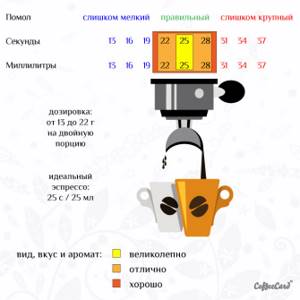
How to set up a coffee machine for different operating modes (2020)
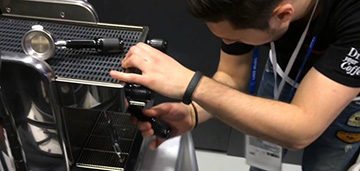
All coffee machines can be divided into two types – simple and complex. Depending on this, we can talk about different programming systems and configuration methods. For example, modern Swiss flagships are a new generation of technology in terms of electronic components and programming. Household models look somewhat simpler, but also require a reasonable approach
Tips for adjusting grinding
- 1.Change only one variable at a time.
- Change only one parameter that affects the final drink, and leave all the rest unchanged. Parameters such as water temperature, coffee dose and brewing method should remain constant.
- Start by adjusting the grind you previously used.
- When purchasing a new coffee grinder, set the grind to the middle position. This is called the "basic setting". Initially, the manufacturer sets the grinding degree to medium by default. The degree of grinding must be changed in such a way that it is: if the grinding is too fine, set larger values; if too rough, lower values.
- Make small changes to different grinder settings.
- After the first cup with the “base setting”, you need to grind two more cups of coffee. If you grind the first cup in step 20, then grind the next ones in steps 19 and 21. One division of the coffee grinder disk is approximately equal to 2 - 3 seconds. extraction. This division price makes it possible to minimize coffee consumption by adjusting the grinding. To change the settings, you need to move the grinding dial in the desired direction a few notches.
- Before tasting, decide on your taste preferences.
- Try the coffee, recording your sensations of aromas and try the coffee slowly.
- Blends and single varieties are brewed differently and have different aromas and tastes.
- Brew several test batches of coffee.
- At a coffee shop, ask a professional barista to grind some of the coffee beans you bought and use it as a reference when making coffee at home. When learning a new skill, cultivate patience.
The grind setting level depends on the coffee grinder model, so the exact position of the millstones can only be determined experimentally.
Once the setup is complete, there is no need to turn off the coffee grinder. Let it run for a while to remove coffee particles from the machine.
To maximize the preservation of essential oils, grinding the beans must be done 5-10 minutes before the brewing process.
Post Views: 1,681
Selecting the grinding degree
Consider the type of coffee machine
Choose a grind depending on your coffee machine. The manufacturer provides information in the instructions.
Interesting! Coffee latte - composition and recipes for making it at home, history of origin
Manufacturers of professional coffee machines recommend using coffee of the same brand.
Brew a test cup. If the drink is watery or very bitter, the degree of grinding is not suitable.
Special espresso blends are produced. They are suitable for all models of coffee makers and are already ground.
The coffee machine cannot be used to brew coffee from ground flavored beans. They contain a large amount of oils that will damage the unit. The article “Which coffee beans is best to choose for a coffee machine” is described in detail.

Grinding degree
In semi-automatic units, the drink is brewed from medium-ground beans. Fine fractions are not used in all brands. They are suitable for models in which steam under pressure passes through the ground grains.
Powdered coffee grinding is not suitable for a coffee machine. Small particles will clog the filter. At best, the drink will cook slowly. At worst, the device will fail.
Large particles will not have time to impart aromatic and taste properties to the water. The drink will be watery.
Automatic devices independently set the degree of grinding depending on the type of drink, temperature and pressure.
The choice of grinding degree depends on the microclimate. Consider humidity and temperature.
If the humidity is above 85%, the coffee beans become slightly larger. The crushed particles become compacted, and the coffee acquires a bitter taste.
At warm temperatures and average humidity, the grains may not have time to impart their flavor to the water. Therefore, they are first compacted in a holder.
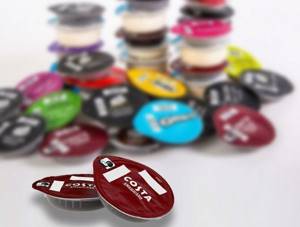
Tassimo wheels
Capsule-type coffee machines brew coffee from T-discs.
Place the capsule in the coffee machine compartment (location depends on the model) and turn on the device.
The device reads the barcode from the disk and sets the parameters for making cappuccino or latte. The needle will then pierce the capsule and a stream of water will flow through the pressed coffee.
The advantage is that there is no need to select the degree of grinding.
Information about the existence of reusable T-disks is erroneous. Such a product is not produced today.
Unscrupulous companies sell supposedly reusable capsules. But they will only ruin the coffee machine.
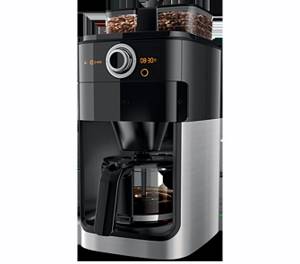
How to adjust the grind
Depending on the model of the device, the degree of grinding can be set with a button on the panel or with a dial-regulator.
The numbers on the regulator are: 1 – fine grinding, 3 – medium, 5 – coarse. The number of digits depends on the model.
The smaller the distance between the millstones, the larger the fractions will be. The first time you try, you may not be able to adjust the desired degree of coffee grinding. Experiment and brew a few cups.
Interesting! What is Robusta and how is it different from Arabica?
The size of the fractions affects the taste of coffee. Coarse grinding produces a drink with a sour taste. From small - with bitterness.
Coffee extraction takes no more than 25 seconds. If less, the grind is too coarse. More - small.
In a unit with a coffee grinder, the beans are crushed to large fractions in about 9 seconds. It takes 15 seconds to get a medium grind. Small – 20 seconds.
